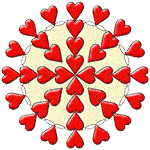

Spend $100 or More & Get 60% off - Use Code BULK60
OR Spend $500 or More & Get 65% off - Use Code BULK65
Spend $1000 or More & Get 70% off - Use Code BULK70
All Sales Final & No Returns. Excludes gift vouchers
I received my first acupuncture treatment when I was 19 and became immediately fascinated with the concepts of Traditional Chinese Medicine. Since then I have studied these principles formally and informally in different settings and started actively working with this system in my healing practice. What follows is a concise description of just a few aspects of a very complex system that was developed more than 3000 years ago. It is not widely known that within this system - along with acupuncture, specific exercises, and herbal remedies - crystals played an important part.
If you’ve had an acupuncture, acupressure, or an Accunect treatment you may have heard your practitioner mention meridians and elements. In these series of articles I’ll briefly discuss their significance and corresponding associations.
According to Traditional Chinese Medicine, a meridian is an “energy highway” along which energy circulates throughout a human body. There are 12 main meridians that connect to the main organs in the body. For those who are curious how this connects to Western medical science, here is a link to read more.
Some Western holistic practitioners have developed their own systems of working with meridians, which somewhat randomly associate specific emotions, organs, and elements to the meridians. In these articles I am drawing directly from the Traditional Chinese Medicine system.
Before we discuss the function of each meridian and their corresponding emotions, affirmations, and crystals, it is important to understand the concept of elements.
Chinese traditional philosophical systems and traditional medicine are based on the concept of Five Elements, which represent fundamental natural elements and their interaction. This is applied to spiritual, mental, emotional and physical aspects of human existence. The elements are Wood, Fire, Earth, Metal, and Water.
Imbalance is defined as both an excessive energy, as well as insufficient energy in an organ/meridian/element.
Wood Element associations:
Organs: liver/gallbladder
Emotions: anger
Balanced: growth, flexibility, generosity, expansion, leadership
Imbalanced: indecisiveness
Fire Element associations:
Organs: heart, small intestine, pericardium, triple heater
Emotions: joy/sadness
Balanced: love, heartfelt connections with others, passion for life, creativity, playfulness
Imbalanced: impatience, restlessness, irritability
Earth Element associations:
Organs: stomach/spleen (+pancreas)
Emotion: worry
Balanced: stability, nourishing experiences, self-confidence
Imbalanced: obsessive thoughts, digestive problems, overeating/not eating enough
Metal element associations:
Organs: lungs/large intestine
Emotions: grief/letting go
Balanced: confidence, organization, discipline
Imbalanced: issues with self-worth, hoarding, clutter
Water element associations:
Organs: kidneys, bladder
Emotions: fear
Balanced: introspection, resiliency, calmness
Imbalanced: anxious, fearful, withdrawn
The natural cycle can be supportive (generating) or destructive (overcoming).
The supportive cycle:
Wood feeds Fire
Fire generates Earth
Earth makes Metal
Metal creates Water
Water feeds Wood
The destructive cycle:
Wood destabilizes Earth
Fire melts Metal
Earth absorbs Water
Metal chops Wood
Water extinguishes Fire
When the elements are in balance relative to one another, they work together for our optimal health. When they are out of balance, due to a variety of reasons, they contribute to the decline of our health. It is beyond the scope of this brief introductory article to discuss the depth with which this is explained within Traditional Chinese Medicine and philosophy. For those who want to learn more I would recommend Power of the Five Elements: The Chinese Medicine Path to Healthy Aging and Stress Resistance by Charles A. Moss M.D. (2010) and The Web That Has No Weaver: Understanding Chinese Medicine by Ted Kaptchuk (2000).
Don't forget to check out the Beginners’ Guide to Meridians and Crystals Part 2
Article By Brana Crystal Cosmopolitan
 (Submitted by: angelique on August 11, 2018) (Submitted by: angelique on August 11, 2018) |
 (Submitted by: Janette Rose on June 14, 2018) (Submitted by: Janette Rose on June 14, 2018) |
 Very nice information.... (Submitted by: Mukesh on April 10, 2018) Very nice information.... (Submitted by: Mukesh on April 10, 2018) |
 Very interesting and informative. I enjoyed this article very much. (Submitted by: RobynS on May 15, 2017) Very interesting and informative. I enjoyed this article very much. (Submitted by: RobynS on May 15, 2017) |
| Read more articles like this in the following category: |
| Crystal Healing Articles |
FACEBOOK
INSTAGRAM